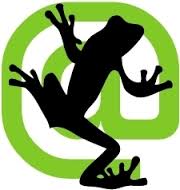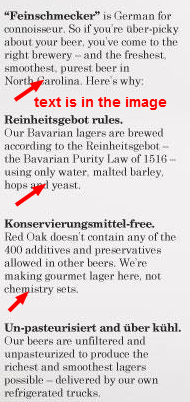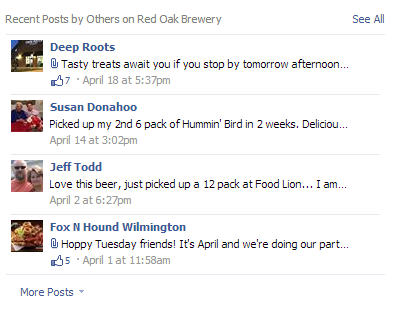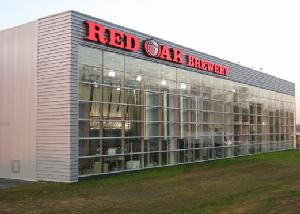 I decided to audit one of my favorite local breweries to see how well they did. They are Red Oak Brewery. Red Oak is a brewing company in Whitsett, North Carolina. Originally started as a brewpub in Greensboro, NC, Red Oak produces only unfiltered, unpasteurized Bavarian Style lagers.
I decided to audit one of my favorite local breweries to see how well they did. They are Red Oak Brewery. Red Oak is a brewing company in Whitsett, North Carolina. Originally started as a brewpub in Greensboro, NC, Red Oak produces only unfiltered, unpasteurized Bavarian Style lagers.
What is an SEO Audit?
The SEO audit process will break down the technical factors that help a website rank and determine if there are problem areas that need improving. It is like a health checkup for your website. The SEO person doing the audit just needs to know the right questions to ask and how to find the information. Most of the questions will be related to the factors that Google uses to rank pages, which can be found in a nice infographic4 main parts of an SEO Audit
- Indexation / Accessibility – This is looking for technical problems that could cause crawlers or users issues, or could otherwise penalize your website.
- On Page Optimization – This includes all the little technical details on the site that Google finds important in ranking your site that you should find important if you want to be found and your business to grow.
- Off Page Optimization – Deals mainly with links / link building and social media.
- Competitive Analysis – How well are you doing vs your competitors?
What you should expect from an SEO Audit
- An analysis of your current website and its current state.
- A list of prioritized actions for improvement.
- A strategy on improvement, and I don’t just mean actions, but a real plan on how you are going to make your website the best.
Starting the Audit Process
There’s a saying that you must crawl before you walk, which in this case is very much true. Because of the size of most sites you might want to go ahead and start a crawl with a program such as Screaming Frog or if the site is large enough you may need to adjust memory settings for screaming frog or consider a cloud based or php crawler.
Indexation and Accessibility Audit
Robots.txt
Once the crawl has started we’ll do some manual checks, is there a robots.txt? www.redoakbrewery.com/robots.txt In this case nope, and in fact I get a 404 error with a different theme, so already I know there are going to be serious problems on this website. What you’d normally look for are any blocked crawlers, disallowed directories or pages, and a sitemap location.Sitemap
Typically a sitemap will be at /sitemap.xml or /sitemap.xml.gz, and again these are not found on Red Oak’s website. The sitemap will tell you information like the number of web pages that Google expects to find and helps Google to crawl them efficiently. Remember to submit your sitemap to Webmaster Tools!Multiple Versions of the Homepage
The next thing to check for is multiple versions of the homepage or gateway pages, in this case redoakbrewery.com gives me 2 choices of places to go, /home.html or /sorry_RA.html. There is nothing to do at /sorry_RA.html, and no links. Since most of the links to a website will come to their main domain, the power coming from these links is being split into 2 parts and then getting lost with /sorry_RA.html page since it is a dead end. It’s also good to check for www.domain.com and domain.com versions, as these are counted as separate pages. In the case of Red Oak, both exist! Also check with and without a trailing slash, domain.com/ and domain.com. Something glaring to me is that the homepage is .html and the links on the site are .php, so what if I try /home.php? I get what appears to be an old version of the site which should have been 301 redirected via .htaccess to the new website.Custom 404 Page
Now try for an error page, type in a url like /adkljkfdasjl and see what happens. In Red Oak’s case, there is a 404 page but it appears to use the old site design with some hidden menu links and simply gives me an error message. A good opportunity with a 404 is to link to your main categories or areas of interest to help people find what they are looking for.Responsive or Mobile?
Is the website a responsive design or does it at least have a mobile version? A responsive website design will scale itself with screen size, hiding or re-sizing objects to work effectively at any size, whether desktop, mobile, or tablet. Red Oak is not responsive and they have no mobile site. I found it very very difficult to even click yes on my smart phone to get to their website as the area for me to click was tiny.
Google Site Search
Now go to Google and use the site operator to return listings, i.e. site:redoakbrewery.com to list out the pages Google has indexed. This should be about the same number as you would typically find in the sitemap, but there are a few things I look for when glancing through. Are there duplication issues? Sometimes a site might have only 500 links in the sitemap but 80,000+ pages indexed in google. Something is wrong in there somewhere and it’s definitely causing duplication. Some of the common culprits are parameters such as query parameters ?=(random string), PPC links or tagged campaigns with utm= will sometimes be indexed, session ids where you will see id=(whatever), searches being indexed where search=(whatever), and internal linking issues where a folder may link to the same folder and you end up with something like domain.com/folder/folder/folder/folder/page. In Red Oak’s case in particular, I see /sorry.php which is the same page as /sorry_RA.html, https://www.redoakbrewery.com/locator/index.html is an old page that should have been 301 redirected, they have /folderofawesome indexed which I can’t find a link to on the current website, /bbdraft.php is another leftover page, there are some ?publisher= parameter and ?src= parameters being indexed as well, ?KeepThis parameter, at least 3 of which are creating duplicates of the main entry pages. These can be easily dealt with by adding a parameter exclusion to Google and Bing Webmaster Tools. Some more of their old pages are left, from beer pages like /bigoak.php, /humminbird.php, /battlefieldbock.php. There is an old flash intro left https://www.redoakbrewery.com/images/main/flashText.swf and some pdfs indexed from events years ago. So many of these should have been 301 redirected to their current pages or at least the homepage.Google Branded Search
Google search again but this time for the company or brand now. You’re looking for bad reviews, anything dealing with ripoff, scam, complaints, or sometimes to see if the brand exists at all in the case of a penalty. No surprise here, Red Oak is great so why would there be anything negative?Whois and Neighbors
Another best practice is to just go ahead and check out the Whois information, so you know more about the domain. https://www.networksolutions.com/domains/whois Next, check who else is hosted in the same neighborhood. https://www.my-ip-neighbors.com/ Look for any bad neighbors related to gambling or drugs or sex, or any websites with the potential to cause slowdowns or crashes of a server.Page Speed
Take your pick of tools or run through all of them. All have their own unique benefits. What you’re typically looking for here is any problems like files that are too big and take too long to load. A lot of times html can be compressed, css and javascript can be minified and combined, and if you need extreme speed you could consider a content delivery network or CDN. Usually problems like too many requests means you need to combine files, or you can uncover redirects that might be slowing your site down or uncompressed images. Speed is a ranking factor, but also affects conversion and sales.
Source: StrangeLoopNetworks
Penalties
If you have more time I always like to check for penalties. Assuming you have Google Analytics access, https://www.barracuda-digital.co.uk/panguin-tool/ will overlay your Analytics data with major updates from Google so if you see a sharp decline in traffic at the same time as an algorithm change, you probably got hit by that change.Subdomains
Typically should be brought into the main domain as a subdomain can be treated as a separate website. It helps to combine the authority by using a folder instead of a subdomain. i.e. domain.com/blog is better than blog.domain.com.Keyword Research
This is also a good time to take a brief look at keywords with the Google Adwords Keyword Tool so that you’re familiar with the industry. I would not go too in depth during an audit into keyword research unless it was for an ongoing marketing client. While I’m sure Red Oak gets a lot of branded search, briefly looking at this I can see a dozen or so good keywords they could target such as craft beer, best craft beer, North Carolina craft beer, North Carolina beer, pint glasses, pint glass, beer glasses for sale, North Carolina brewery, breweries in NC, breweries in North Carolina, NC craft beer, NC beers, beer gifts, beer gift baskets, beer gift basket, gifts for beer lovers, brewery tours. So you can see from a business standpoint where beer related gifts might be a huge missed opportunity for them.Analytics
Just make sure some kind of analytics are installed, and also check to make sure the code is up to date. They have Google Analytics installed. I recently audited a site that was still running urchin analytics code, which is now years out of date.Markup and Structured Data
Are these items present? Google will likely be using these more and more in the future to identify items on a page. Google’s Structured Data Testing Tool and Schema.org.On Page SEO Audit
Title Tags
One of the most important parts of a web page, this tag shows at the top of the browser and the first line of a search result on Google. With Screaming Frog and Excel you can quickly identify issues such as duplicates, titles that are too long, and where your keywords are in your title (they should be at the beginning.) So with Red Oak with have lots of duplicate titles, they all start with Red Oak Brewery, and a lot are way too short. Google is displaying search results differently than they used to, and there is a good analysis and testing tool posted here: https://moz.com/learn/seo/title-tagMeta Descriptions
This is your sales text, the 2 lines below the title tag when you search in Google. While this isn’t really counted for ranking purposes, it can affect your click through rate in Google. For instance keywords searched for will be bolded and help them stand out but also a strong call to action in the description can increase the number of people who choose to click the search result. For Red Oak, they have several descriptions over 200+ characters, others are duplicates like the description tag for their humminbird beer is also used on the charitable gifts page.Header Tags H1 – H6
I can’t even begin to tell you how many sites I’ve audited where the header tags had issues, everything from completely missing the tags to multiple H1s on the same page. A lot of times, because the H1 tag is used as a design element, whenever the designer wants a certain size of font, this is what they will use. This is an important ranking element and should be keyword rich. If you must use it on the logo at least make sure there is alt text, but try not to use it on a logo for product pages as more than likely what you want to target with a product page is the name or type of product. There are instances where multiple H1s are acceptable, after all websites have changed a lot and maybe your page is about several items, all of equal importance. For Red Oak, there is no H1 tag on the homepage, and other pages use non-descriptive tags such as “History” when it could be “History of Red Oak Brewery,” still other pages have multiple H1 tags, so lots of issues here. H2-H6 should be used more for subheadings and can be keyword rich, though they’re not as important as the H1 tag.URLs and Structure
Permalinks!! You want to avoid excessive parameters and make sure your URLs have a logical structure and are keyword rich, everything from the page to the categories. Best practice is hyphens to separate words. Avoid session ids and have static urls whenever possible. The biggest issue Red Oak has here is a combination of html and php pages, even using 2 different designs on the site.Canonical
This tag is used to alleviate duplicate content issues by attributing one page’s content to another page. Has not been set for Red Oak.Images
- Web optimized for fast loading?
- Descriptive alt tags containing keywords being targeted?
- Image file names should contain keywords, an often overlooked element.
Broken and Redirected Links, Internal and External
Screaming Frog will give you a great list here. You’re looking for broken or malformed internal links, possibly pages that were removed and should have been redirected. If you have internal redirects then you have links that should be updated. Same with external links, most sites will link to pages or sites that no longer exist, or there will be a redirect to a new page. All of these should be updated. Red Oak has a link to buy their old brew pub for instance which is a broken link.Navigation
Make sure the navigation is clear and makes logical sense. Also make sure the navigation menu is not hidden in javascript or an iframe. These can prevent proper indexing.Content and Duplicate Content
Make sure there is no hidden text, such as the text in images on the Red Oak homepage. Other common sources are text hidden in an iframe or javascript. While these can be used to somewhat prevent duplicate content on huge, database driven websites, it is still not a “best practice.” Also make sure content is not duplicate across multiple websites. I recently audited a site that had over 10 exact copies in a particular niche and even their “unique blog articles” offered by their current company were on all of these. Product images, descriptions, etc were all the same, only the logo and a few layout changes were made. With a lot of websites, companies will copy manufacturer sales text for the product page, which is okay but they should at least add something to it to make it unique and not duplicate. Bold and italics are ranking signals as well for important keywords, are you using them? Kind of subjective, but is the content keyword rich and of a good length?Internal Link Opportunities
These are links from your pages to other pages on the site, inside the content of the page and not just the navigation. A lot of times a related post plugin or links in author bios are great places to beef up the internal link count, but remember that links in your content using varied anchor text is important! Red Oak seems to have avoided the opportunities they have to link to their own products and pages.Pagination
Rel=”next” and rel=”prev” are used to tell search engines how to handle pagination.Authorship
This is how you setup a link between your blog posts and your Google+ profile which gets the nice image in search results. Rel=”author” check if you are using it, and if not then you should be since the picture stands out and increases the click through rate.
your Google+ profile which gets the nice image in search results. Rel=”author” check if you are using it, and if not then you should be since the picture stands out and increases the click through rate.
Publisher
The rel=”publisher” is similar to rel=”author” but it links pages on your website to your business Google+ page. For branded searches, this takes up an extra bit of real estate on the right hand side by bringing up the Google+ information of the business page.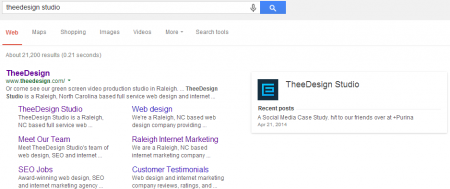
PDFs
This is often overlooked, but PDFs are indexed as pages by Google. They are read and internal links from them count, so put links in your PDF! Name your PDF something keyword rich as well. They also have their own tagging system that works similar to meta tags for webpages but are rarely ever filled out. Go to File > Properties to see these fields.Videos
Video optimization is also overlooked a lot of times. Again everything from naming the video with keywords, tagging it properly, good descriptions, etc.Indexed, noindexed
Tag pages for wordpress are often indexed along with category, author, and archive pages, all causing duplicate content issues. Login pages and secure areas like shopping carts should also be noindexed.Opportunities
This can be anything related to the business. It could be their contact button is a color that less people click or blends in with their site design, or there is no clear and outstanding call to action, or maybe they should have a newsletter signup, or in the case of Red Oak, they have products such as glasses that they could sell online but do not. For Red Oak, their biggest opportunities in my opinion are in social but I’ll get to that later in the article.Sales Funnel or CRO (Conversion Rate Optimization)
Generally a product page will have some kind of call to action, so everything from here to checking out or filling out a contact form can be looked at. The more information you require for a contact form, the less people that fill it out. The longer the process, the more people you lose. Do their contact forms use validation? i.e. Can I enter letters in the phone number field? Most companies don’t like spam, and validation of the contact form is one way to cut it down. Adding captcha as a lot of companies do will not usually stop the spam, but it will lose you valuable customers. Testing of different text, images, form sizes, adding image progress during a checkout, even infographics on contact pages are all becoming common and can be easily split tested to improve conversion.Favicon
Just a little branding nicety that shows up in the tab and in bookmarks to identify your site.Coding
I will touch on this briefly, you can use one of the validators for code such as https://validator.w3.org/ or https://jigsaw.w3.org/css-validator/ but with Red Oak the main problems are coding errors because it looks like each page was individually coded and the pages also use deprecated code, which is code that has been phased out of use and while browsers may still support the features, who knows how long that will be the case.Social Media
For this part I simply mean social media icons or links to social media on the page. These should contain alt text with a little more description than Facebook, such as (Company Name) on Facebook, and should also include the rel=”me” attribute to claim the profile. Including your company name in these links will help your profiles rank for your branded search terms.Check Multiple Sections of the Site
On a final note, remember that when you are checking on page elements that they can often differ between the main page, category pages, product pages, forums, blogs, profiles, etc. Header tags are a common example of this, maybe the H1 tag is present on the homepage in the logo, but maybe it’s also in the logo on a product page rather than the name of the product. Sometimes sites use entirely different Content Management Systems for different sections of the website, so each will have it’s own unique challenges.Off Page Audit
Domain Metrics
Google has their own page rank, but Moz has everything from rank to trust to authority. This gives you an indication of the strength of the sites linking to you and your own strengths. Also look at the number of links, number of referring root domains, linking C Blocks, etc.External Links
Ahrefs or Moz or Google Webmaster tools will give you all sorts of data for this. You should be looking at not only where you get your links, but where your competitors get their links and competitors in major market areas get their links. Generally you will find some must have links from doing this. Links from edu, gov, Wikipedia, news sites, niche websites in your industry, relevant blog comments, on topic forum posts, social profiles, local citations, etc. are all good. Spammy directories and spammed forums and blogs are bad.Anchor Text Distribution
You want a natural link profile with varied anchor text. Not enough using keywords to get a penalty, but enough to rank for the terms you are targeting.Deep Links
You’re also looking to see if all of your links go to your homepage only or if you have deep links to product and category pages which is preferable. This is often overlooked and a big missed opportunity as you can’t expect your homepage to rank for every term that you target. Red Oak has a lot of missed linking opportunities that some other North Carolina brewers are taking advantage of. Their domain authority is low comparatively, but their main issue with linking again is that most links go to the domain itself where they have a gateway page and then tons of duplicate versions of the homepage as well. Just curious what was typical in the industry, I popped over to Sam Adams website and my guess is there is some law that says they have to have users state they are above drinking age to view the content, but Sam Adams does it with javascript, so the user sees this and has to agree, but the search engine will ignore it and see the content. All the links will still be to the main page when done this way.Social Media Audit Summary
Facebook: 10,197 people like Red Oak on Facebook when I checked (including me) and yet their last post was in May of 2013. This is a huge advertising platform for them, and they don’t use it. Even without using this channel, people are still talking about them! Sadly, all the questions, comments, recommendation and good chances for PR for Red Oak are being missed.
Twitter: again is a missed opportunity. There are 3,606 followers at the time of this writing. There was one tweet in early February, and before that you have to go back to August. Most of the tweets are just re-tweets and you have to go back to May 2013 for their last real activity on Twitter.
Blog: bring blog on site and be active! The last and only post on the Blogspot blog was in January of 2013. This is a beer company, you could do so much fun and cool stuff, and get huge amounts of user interaction just by saying something like take a picture with your Red Oak t-shirt on, or with your favorite Red Oak glass. The guys at Red Oak are supremely knowledgeable and passionate about beer, they could be pumping out articles and great ideas left and right. Most breweries are making new beers or experimenting with something all the time, so this would be a great opportunity for blog content that people would love to hear about.
Social Statistics
Sites like https://www.sharedcount.com/ can give you an idea of how popular a company is on social media platforms.Brand Claimed
Check for instance Knowem.com to see the platforms where the brand name has been claimed.Optimized for Social Sharing
This is missed a lot but there are tagging options that allow for proper social sharing on various platforms. You can check and see how you are doing with https://smo.knowem.com/Finalizing Our SEO Audit
Even the greatest new website design can be riddled with the technical flaws we have covered. Proper on site optimization is important, because not following guidelines or having technical issues can severely dampen the power of your website and link building efforts. If you get your new website and you traffic has dropped, or maybe you have disappeared from the rankings, just remember that a beautiful website is not always a technically sound website. There can be ugliness that Google does not like hiding below.With TheeDigital, you can have both a great looking website that is also technically sound and optimized to get you rankings and traffic! Schedule a consultation or call 919-341-8901 to speak with our award-winning team of web designers and internet marketers today.
P.S. We love you Red Oak and thank you for being our guinea pig for this article. We love your beers and want you to succeed! Tags: Digital Marketing • Search Engine Optimization • Web Design


